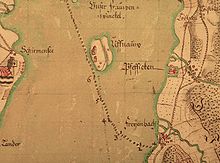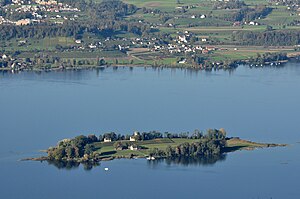Ufenau
| Ufenau | ||
|---|---|---|
| Ufenau island, view from Etzel (mountain) | ||
| Waters | Lake Zurich | |
| Geographical location | 701 727 / 230550 | |
|
|
||
| length | 470 m | |
| width | 220 m | |
| surface | 11.26 ha | |
| Islands of Ufenau (left) and Lützelau from the southeast | ||
Ufenau or Ufnau ( Insel des Ufo, Offo or Ubo ) is located in Lake Zurich and is the largest island in Switzerland that is not connected to the mainland by a bridge. The island and its neighboring island of Lützelau are close to Pfäffikon SZ . While Einsiedeln Abbey used the original name Ufnau as the owner , the state topography and shipping company write Ufenau .
The island belongs to the territory of the political municipality of Freienbach and is the property of the Einsiedeln monastery .
protection
Due to the idyllic location, the scenic beauty and biological diversity as well as the extremely rare cultural-historical continuity, the Ufenau enjoys a protection that is unique in Switzerland: The island is part of object no. 1405 "Frauenwinkel-Ufenau-Lützel" of the federal inventory of landscapes and natural monuments of national importance BLN and part of object no. 351 “Frauenwinkel” of the federal inventory of moorland landscapes of particular beauty and of national importance. The “Ufenau site of national importance” is part of the inventory of sites in Switzerland that are worthy of protection, ISOS. The Ufenau nature and landscape are also under the special care of the Canton of Schwyz through the “Ordinance on the Protection of the Women's Corner”.
history

Diving archaeological research has unearthed prehistoric and early historical cultural landscapes around the nearby lake dam. South of the Ufenau there were stakes from the 14th – 13th centuries. Century BC BC, prehistoric pottery shards prove the presence of humans, although there is no clear evidence of settlement. Around the year 200, during Roman times , there was a Gallo-Roman temple on the island . Its foundations are contained in the foundation walls of St. Peter's Church. A first church was probably built in 500 on the site of today's St. Martin's chapel. St. Martin was the center of a large parish that stretched from Altendorf to Wädenswil and from Feldbach and Hombrechtikon to Erlenbach, but which had its administrative seat on the mainland in Pfäffikon ( Phaffinchova = court of the priest).
The first written mention ( Hupinauia ) is a document from the year 741, in which the Alemannic landowner Beata donated the monastery on the neighboring Lützelau. It is not known whether the Ufnau also belonged to the von Beata family. In 965, Emperor Otto gave the island, which at that time belonged to the Säckingen Abbey, to the Einsiedeln monastery. In the 10th century, the Swabian Duchess Regelinda had the Church of St. Peter built, next to it a house where she lived with her youngest son, Adalrich , who was later canonized . He died on the island around 973. His relics lay in a shrine in St. Peter until the Toggenburg War in 1712.
The humanist Ulrich von Hutten died on August 29, 1523 on the Ufenau . Conrad Ferdinand Meyer mentions them in Hutten's last days of poetry .
When all the monasteries were closed for a short time during the Helvetic Republic, the canton of Linth sold the island to a private individual. With the mediation constitution , Einsiedeln Monastery was restored, which bought the island back in 1805.
From 2003 it was planned to rebuild the excursion restaurant with a project by Peter Zumthor . At the end of 2011, the federal court ruled that it must not be rebuilt in the moorland. In 2017 the restaurant was restored and renewed, the island was closed to visitors for a year and a half.
Ufenau in numbers
- Area: 112,645 m²
- Average length: 470 m (east-west)
- Average width: 220 m (north-south)
- Distance to Rapperswil ( Rapperswil-Jona ): 2.5 km
- Distance to Pfäffikon SZ : 0.9 km
Attractions
- The former parish church of St. Peter and Paul , built in 1141
- Chapel of St. Martin
- Grave of Ulrich von Hutten
- Tomb and sarcophagus of St. Adalrich
literature
- Leo Helbling: Ufnau: The monastery island in Lake Zurich. Little guide. 3. Edition. Stäfa: Th. Gut, 1983, ISBN 3-85717-035-2 .
- Leo Helbling: The island of Ufnau: small guide . Stäfa: Th. Gut, 1986.
- Hannes Kappeler: The island of Ufnau . [Winterthur]: [H. Kappeler], [2009].
- Odilo Ringholz; Damian Buck: History of the island of Ufnau in Lake Zurich . Einsiedeln: Benziger, 1908.
- Rudolf Henggeler : The island of Ufnau A guide through the history of the island, its inhabitants and customs . [Pfäffikon]: [Lieutenancy], 1927.
- Reto Bodmer; Harry Pfister; Alois Suter: Chronicle of Ufnau, Frauenwinkel, Lützelau, Pfäffikon and Hurden . Freienbach: Suter, 1975.
- Anja Buschow Oechslin: The art monuments of the canton Schwytz. Schwyz IV. District Höfe. Edited by the Society for Swiss Art History GSK. Bern 2010 (Art Monuments of Switzerland Volume 118). ISBN 978-3-906131-93-1 .
Sacred buildings
- Fredy Kümin, Markus Bamert, Peter Ziegler, Valentin Kessle: The sacred buildings on the island of Ufnau . (Swiss Art Guide, No. 856, Series 86). Ed. Society for Swiss Art History GSK. Bern 2009, ISBN 978-3-85782-856-0 .
- Peter Ziegler: Frescoes in the churches on the island of Ufnau and in the tower choir of the parish church in Freienbach . Freienbach: Bruhin, 1975.
See also
Web links
- Ufenau website
- Website: Friends of the Island of Ufnau
- Paul Wyrsch-Ineichen: Ufenau. In: Historical Lexicon of Switzerland .
- The history of the Ufnau
- Building and Art History Ufnau
- Gallo-Roman Temple Ufenau ( Memento from July 17, 2004 in the Internet Archive )
Individual evidence
- ↑ a b c d Peter Ziegler: History of the island of Ufnau
- ^ History of the Säckingen monastery and its founder, St. Fridolin
- ↑ Walter Bernet: The holy island in Lake Zurich welcomes guests again . In: Neue Zürcher Zeitung . No. 92 , April 21, 2018, p. 21 ( nzz.ch [accessed on April 23, 2018]).






